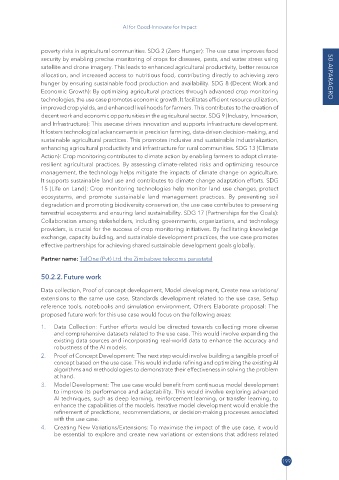Page 215 - AI for Good-Innovate for Impact Final Report 2024
P. 215
AI for Good-Innovate for Impact
poverty risks in agricultural communities. SDG 2 (Zero Hunger): The use case improves food
security by enabling precise monitoring of crops for diseases, pests, and water stress using
satellite and drone imagery. This leads to enhanced agricultural productivity, better resource
allocation, and increased access to nutritious food, contributing directly to achieving zero 50-AIPARAGRO
hunger by ensuring sustainable food production and availability. SDG 8 (Decent Work and
Economic Growth): By optimizing agricultural practices through advanced crop monitoring
technologies, the use case promotes economic growth. It facilitates efficient resource utilization,
improved crop yields, and enhanced livelihoods for farmers. This contributes to the creation of
decent work and economic opportunities in the agricultural sector. SDG 9 (Industry, Innovation,
and Infrastructure): This usecase drives innovation and supports infrastructure development.
It fosters technological advancements in precision farming, data-driven decision-making, and
sustainable agricultural practices. This promotes inclusive and sustainable industrialization,
enhancing agricultural productivity and infrastructure for rural communities. SDG 13 (Climate
Action): Crop monitoring contributes to climate action by enabling farmers to adopt climate-
resilient agricultural practices. By assessing climate-related risks and optimizing resource
management, the technology helps mitigate the impacts of climate change on agriculture.
It supports sustainable land use and contributes to climate change adaptation efforts. SDG
15 (Life on Land): Crop monitoring technologies help monitor land use changes, protect
ecosystems, and promote sustainable land management practices. By preventing soil
degradation and promoting biodiversity conservation, the use case contributes to preserving
terrestrial ecosystems and ensuring land sustainability. SDG 17 (Partnerships for the Goals):
Collaboration among stakeholders, including governments, organizations, and technology
providers, is crucial for the success of crop monitoring initiatives. By facilitating knowledge
exchange, capacity building, and sustainable development practices, the use case promotes
effective partnerships for achieving shared sustainable development goals globally.
Partner name: TelOne (Pvt) Ltd, the Zimbabwe telecoms parastatal
50�2�2� Future work
Data collection, Proof of concept development, Model development, Create new variations/
extensions to the same use case, Standards development related to the use case, Setup
reference tools, notebooks and simulation environment, Others Elaborate proposal: The
proposed future work for this use case would focus on the following areas:
1. Data Collection: Further efforts would be directed towards collecting more diverse
and comprehensive datasets related to the use case. This would involve expanding the
existing data sources and incorporating real-world data to enhance the accuracy and
robustness of the AI models.
2. Proof of Concept Development: The next step would involve building a tangible proof of
concept based on the use case. This would include refining and optimizing the existing AI
algorithms and methodologies to demonstrate their effectiveness in solving the problem
at hand.
3. Model Development: The use case would benefit from continuous model development
to improve its performance and adaptability. This would involve exploring advanced
AI techniques, such as deep learning, reinforcement learning, or transfer learning, to
enhance the capabilities of the models. Iterative model development would enable the
refinement of predictions, recommendations, or decision-making processes associated
with the use case.
4. Creating New Variations/Extensions: To maximise the impact of the use case, it would
be essential to explore and create new variations or extensions that address related
199

